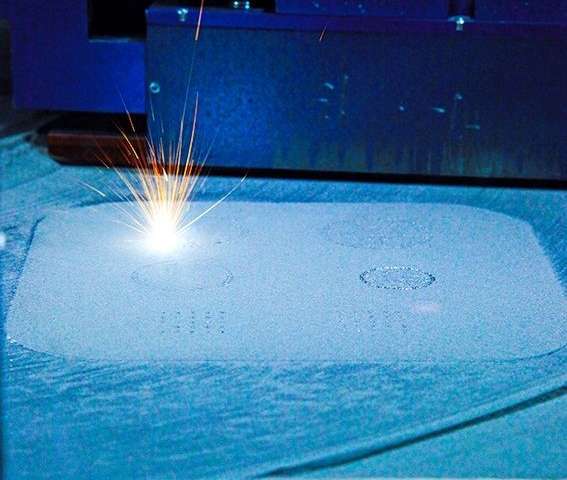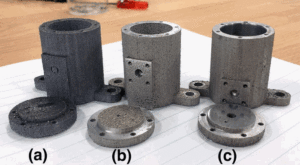Well, a team of Australia-based researchers from the University of Melbourne and the University of Western Australia have just released a report that shows Hoffman’s hopes coming to fruition. The research team was able to 3D print a resonant microwave cavity from viaan aluminum-silicon alloy (Al-12Si) material, which successfully showcased superconductivity when cooled below the critical temperature of aluminum, which is considered to be 1.2 Kelvin. This breakthrough research could have a major impact on quantum physics and particle accelerators, and puts the electrical properties of 3D printing materials in the much-deserved spotlight.
“The physics of superconductivity is well understood, and it has been known for decades that aluminum exhibits superconductivity,” Professor Michael Tobar, University of Western Australia node director of the Center for Engineered Quantum Systems, said. “But the 3-D printing process relies on aluminum that’s far from pure and it undergoes several processes—atomization, laser melting, furnace annealing, etc. So we wanted to explore whether a range of known superconducting metals could successfully be 3-D printed and retain their desirable electrical property.”
The researchers utilized a selective laser melting 3D printing technique for their experimentation, which uses a grain-based material to produce metal-based objects. The research team found that, not only do dissimilar materials have different electrical properties from one another, but the superconductivity of the object is also directly influenced by the grain size of the material. The team found that the grain size can increase and decrease the critical temperature needed to reach superconductivity, which lead them to hypothesize that reducing the grain size could enable more advantageous 3D printing methods in regard to superconductivity.
To prove the usefulness of their research, the team decided to 3D print the resonant microwave cavity. Using a device called a ‘vector network analyzer’, the research team managed to excite the electromagnetic modes of resonance at microwave frequencies inside the cavity, and measured then measured how long these injected microwaves are able to be stored within the 3D printed cavity before dissipating (known as the Q-factor). The research findings are set to be of immediate use for people looking to 3D print magnetic shielding for experimentation, and will also benefit any cavity experiment requiring a Q-factor measurement. Still, the research team acknowledges that there’s much more work to be done in this field before we fully actualize quantum 3D printing.
“There is relatively little in the literature regarding 3-D printed superconductors, so further work must be done to determine more appropriate materials and how to improve the surface finish and resistance of the parts—possibly via heat treatment or chemical polishing/etching,” said Tobar.
Next, the Australian research team will conduct a similar experiment with another material widely used to produce superconductive cavities, a highly pure niobium powder. The team expects similar or even more successful results with this pure metal powder, especially with the newfound information they’ve discovered on the impact of a material’s grain size. By exploring and enhancing the superconductive properties of these 3D printed cavities, the research team is pushing Hoffman’s dream of quantum 3D printing towards reality.
This week, their research will be published and appear on the cover of the academic journal Applied Physics Letters. Headed by Professor Tobar, the rest of the research team included Daniel L. Creedon, Maxim Goryachev, Nikita Kostylev, and Timothy B. Sercombe. Discuss this topic further in the 3D Printing & Superconductivity forum over at 3DPB.com.
[Source: Phys.org]Subscribe to Our Email Newsletter
Stay up-to-date on all the latest news from the 3D printing industry and receive information and offers from third party vendors.
Print Services
Upload your 3D Models and get them printed quickly and efficiently.
You May Also Like
Havaianas Collaborates with Zellerfeld to Launch 3D Printed Flip-Flops
The shoe of the summer is undoubtedly the flip-flop. Easy on, easy off, your feet won’t get sweaty because there’s not much material, and they’re available in a veritable rainbow...
UCLA Researchers Develop 3D Printed Pen that May Help Detect Parkinson’s Disease
Diagnosing Parkinson’s disease is difficult. Often, early symptoms of the progressive neurological condition may be overlooked, or mistaken for signs of aging. Early diagnosis can help save lives and improve...
Printing Money Episode 30: Q1 2025 Public 3D Printing Earnings Review with Troy Jensen, Cantor Fitzgerald
Printing Money is back with Episode 30, and it’s that quarterly time, so we are happy and thankful to welcome back Troy Jensen (Managing Director, Cantor Fitzgerald) to review the...
Heating Up: 3D Systems’ Scott Green Discusses 3D Printing’s Potential in the Data Center Industry
The relentless rise of NVIDIA, the steadily increasing pledges of major private and public investments in national infrastructure projects around the world, and the general cultural obsession with AI have...



































